We make a trellis for cucumbers with our own hands
Little-known fact - cucumbers belong to wild plants and, like vines, stretch up to the sun and twine around growing plants or supports. A good yield is possible if not only regular watering and feeding is observed, but also the creation of favorable conditions for development. For these purposes, it is most practical to use trellises - special designs that help keep garden vines in an upright position without sagging. Moreover, it is not at all difficult to build a trellis for cucumbers with your own hands on the site.
Content
Benefits of trellis growing
The most obvious advantages of the trellis method of growing cucumbers are increased plant productivity, lengthening the growing season and efficient use of the planting area. With proper care from 5 square meters, you can get 60-90 kg of high-quality and healthy green leaves. In addition, the cucumber trellis allows you to organize the optimal air-light regime for all plants. Since in well-ventilated crops the difference in daily temperatures is not so noticeable, as a result of which, less droplet-liquid moisture is formed on the lower part of the leaf, and between the rows the soil surface remains unoccupied for the entire growing season.
Crop care is greatly facilitated. The fruits are clean, do not touch the damp ground, do not rot and are always in sight, so it is easy to assess their degree of ripeness and avoid overripening. Harvesting also takes less time and is less traumatic for the plant itself, since the stems and shoots do not need to be turned over. Practice has shown that tied plants minimize the risk of infection with downy mildew and other diseases.

Cucumber trellis can be equipped on any available vertical surface, be it a pillar, wall, fence, using a stretched string or wire. They will serve not only as a decorative decoration of the site, but will allow to shade those places that are necessary.
Trellis design
Tapestries for cucumbers can have a wide variety of designs in the form of a square, a curbstone, a rectangle, a tent. The support is made both from metal pipes, cement pillars, and from wooden bars or thick branches.
Often, gardeners do not spend much on a trellis and prefer to build it from PVC mesh or twine. For this, two pillars with a height of 1.5-1.8 m are driven in along the edges of the beds, the third is strengthened from above horizontally, in order to further twine twine around it or fix the net. Otherwise, when the fruits are heavy and poured, it can break, slide down and damage the bush. Pegs are driven in on both sides of the planned garden bed. The thread is pulled in a zigzag manner between the vertical posts, then wrapped around the transverse one and fixed on a peg.
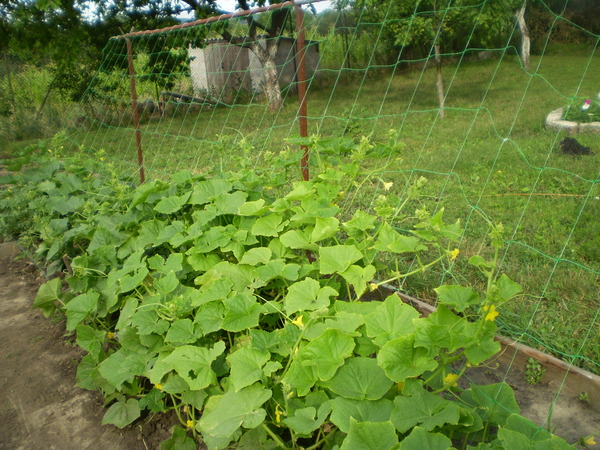
Do-it-yourself tapestries
Wood trellis
A wooden trellis can be made from flexible branches or, more durable, from planed strips. It looks like a wall bars or a school horizontal bar. Cells 15-20 cm wide are made from the slats. The width of the slats should be at least 3-4 cm, horizontal posts - at least 5-7 cm, vertical bars - 4-6 cm. The slats are knocked into a rhombus or square using nails or self-tapping screws and attached to a base of bars. This version of the trellis has a very decorative look and adorns any area.

Metal trellis made of reinforcement
For the construction of a metal trellis from reinforcement, two pipes 180-200 cm long are dug into the ground from both ends of the bed.The depth of installation of the pillars is 35-45 cm. into the ground, fill the hole and compactly ram the soil. Next, the horizontal bar is fixed by electric welding. Similarly as in the version with a wooden trellis, pegs are driven in on both sides of the bed and twine or wire is pulled. The metal trellis must be covered with a primer or some other anti-corrosion compound to avoid rust.
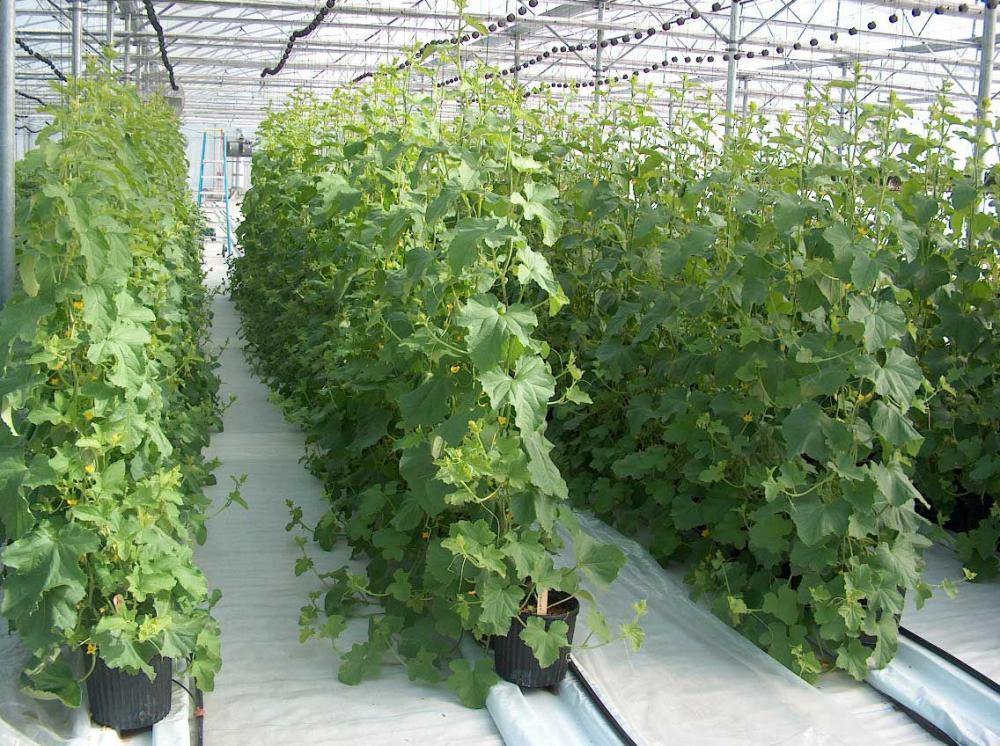
Tapestry from wheel rim and tire
Cucumber tapestries can also be made from bicycle wheel rims or tires. For this, tires from under large-sized machines - a tractor, truck or combine are suitable. One side of the tire is cut and placed in place. Insert two rods into it crosswise, with a convex arc outward. Inside, the tire is covered with soil and covered with a cut bag, tucking the edges under the wheel. Holes are cut in the burlap, seedlings are planted in them and covered with polyethylene or agrofibre, raising it while loosening or watering. When the cucumbers grow to 30-35 cm, the bag and covering material are removed, and a post with a horizontally fixed rim of a bicycle wheel is placed in the center. From the base of the tire, twine or wire is pulled to it. If you have difficulty purchasing a tire, you can pull the thread from the rim to the pegs driven into the ground.
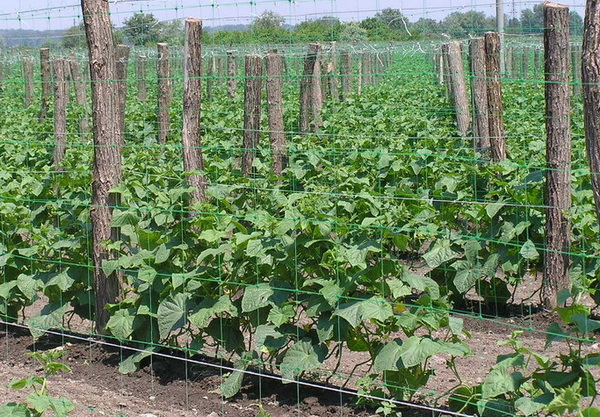
Irrigation
Continuous moistening of the soil, which is often used in vegetable growing, when growing cucumbers using the trellis method, has a number of significant disadvantages before drip irrigation. It requires a lot of water. At the same time, the plants are supplied under low pressure with a liquid nutrient solution, which corresponds to the biological characteristics of development and the soil and climatic conditions of their cultivation. Drip irrigation systems by design type can be seasonal-stationary or seasonal. In a seasonal system, the entire irrigation and distribution network is installed at the beginning of the growing season and dismantled at the end. With a seasonal stationary system, the distribution network is buried and stationary, and the irrigation network is made of polyethylene pipes, with seasonal action.
Outlets are located at a distance of 15-35 cm from each other. The need for a cucumber in water depends on the phase of its development. The first watering is carried out immediately after sowing in order to get friendly shoots. During the growing season and fruit formation - as the soil dries out, without moistening it deeper than 16-22 cm. During the period of active fruiting, the soil is moistened by 28-35 cm at least every 3-5 days, preventing waterlogging of the soil.
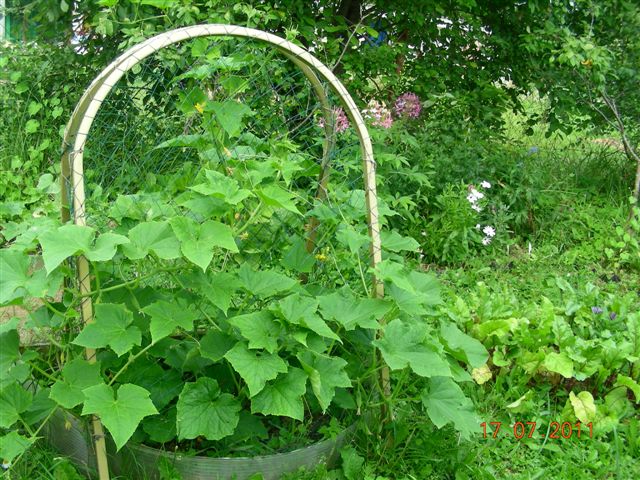
Planting cucumbers and care
Soil and seed preparation
The soil for planting should be started from the fall of the previous year. For each square meter, 22-24 g of urea, 25-28 g of superphosphate, 12-15 g of potassium chloride and 6-8 kg of humus or mullein are added. They are dug up and left to winter open, trapping snow on the site in winter. In early spring, at the beginning of April, the site is loosened to a depth of 7-10 cm. After that, it is divided into cages to fix the trellis posts, leaving the row spacing of at least 90-120 cm. After the posts are installed, the soil is shallowly loosened again. Before planting, pull twine or galvanized wire with a diameter of at least 2.5-3 mm between the posts in 3-4 horizontal rows. In such a way that the bottom row of wire is at a distance of 16-19 cm from the soil, the second and third at a height of 50-70 cm from the bottom row, and the fourth - at the height of the posts of the trellis for cucumbers, no more than 170-180 cm.Then the furrows are cut to a depth of 10-13 cm.
Basically, when growing cucumbers on a trellis, a seedless method is used. Before sowing, they are calibrated for 8-12 minutes in a 3% salt solution. In this case, undeveloped, lightweight or empty seeds float, and heavy ones sink to the bottom.Then they are washed and if they were not initially processed by the manufacturer, they are placed for 12-18 hours in a solution of trace elements - 0.5-1 g / l of manganese sulfate, 0.2-0.3 g / l of boric acid, 0.2-0 , 3 g / l of ammonium molybdate. This stimulates the vital activity of the plant at the beginning of growth and development, increases resistance to diseases. Then the seeds are dried in natural conditions until flowing.
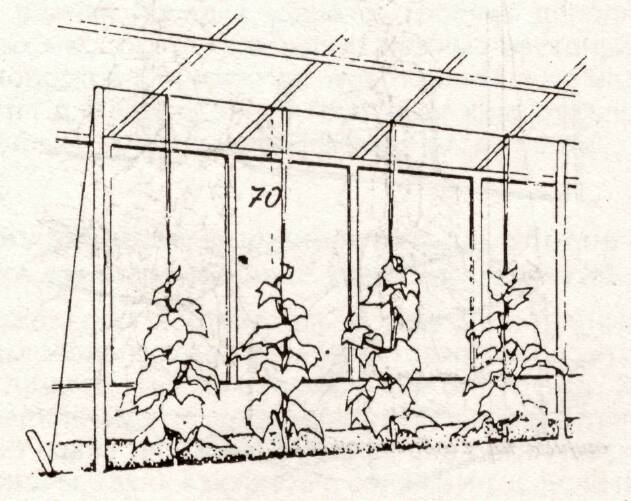
Landing
Seeds are sown in open ground in late April - early May, ready-made seedlings - in the second half of May. As a rule, a wide-row and two-row belt sowing method is used according to the scheme 35-45 cm between rows, 140-170 cm between rows and 20-25 cm between seeds. Immediately before planting, the hole is watered abundantly.
Seedlings are planted when 3-4 true leaves are formed. Density of standing of plants per 1 sq. M 4-5 pcs. Sometimes an additional row is sown between the rows of the trellis, which is not fixed to the cucumber trellis. The land is slightly compacted, abundantly watered and mulched. Waterlogging is not allowed to prevent decay of the root system. During the fruiting period, the amount of watering is increased.
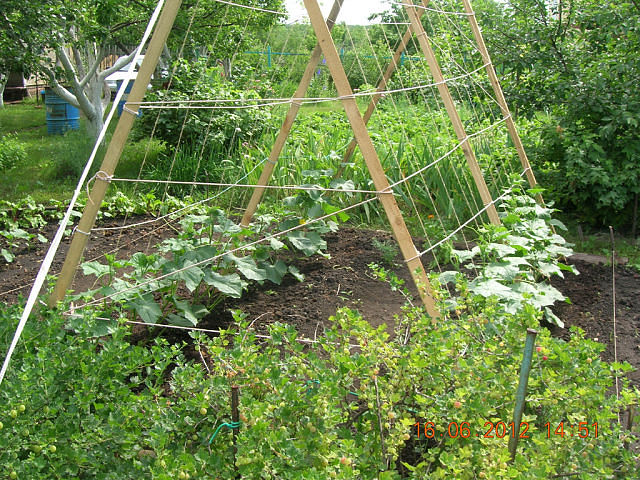
Care
To reduce the risk of planting damage by fungal diseases, it is better to water the cucumbers in the furrows, and not by sprinkling. Depending on the temperature and dryness of the air, watering is carried out 2-4 times a week, early in the morning or in the evening. After the appearance of 2-3 leaves in the seedlings or after complete adaptation of the seedlings, twine is pulled near each plant, slightly twisting cucumbers on it to set the direction of growth for them.
In the phase of 3-5 leaves, the first organic feeding is carried out (100-150 g of chicken manure per bucket of water) together with preventive treatment with copper-containing preparations or Bordeaux liquid. This spraying is repeated immediately after flowering and 5-8 days after the appearance of small ovaries.
Video "Do-it-yourself metal trellis"
This video shows how to build a metal trellis for cucumbers.
